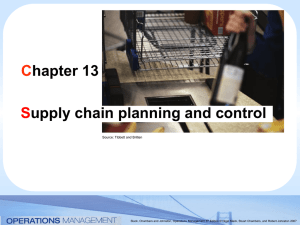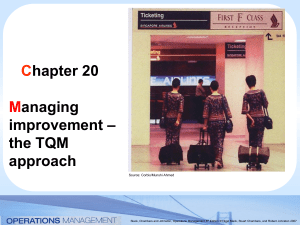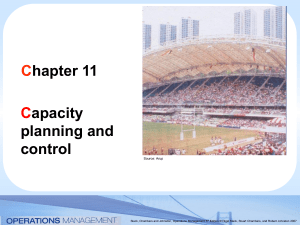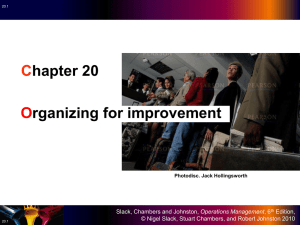PowerPoint Presentations 11
advertisement
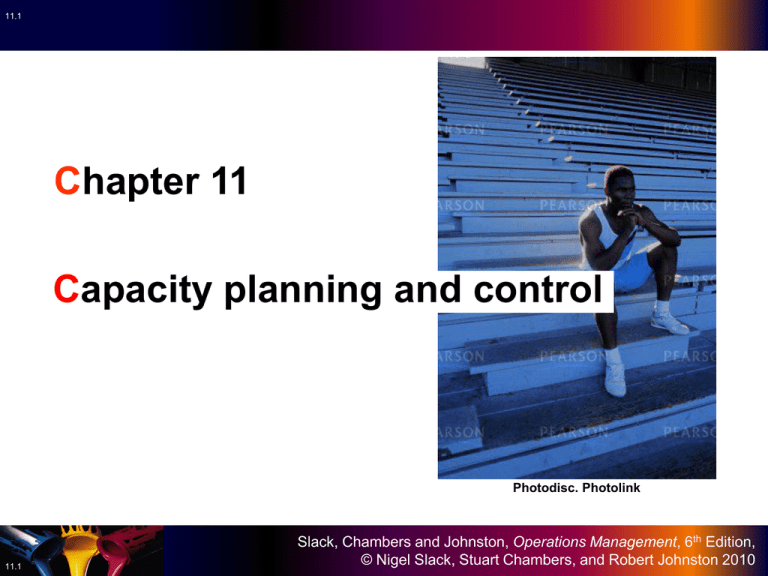
11.1 Chapter 11 Capacity planning and control Photodisc. Photolink 11.1 Slack, Chambers and Johnston, Operations Management, 6th Edition, © Nigel Slack, Stuart Chambers, and Robert Johnston 2010 11.2 Capacity planning and control Operations strategy Design Capacity planning and control Improvement Planning and control The market requires… the availability of products and services The operation supplies… the capacity to deliver products and services 11.2 Slack, Chambers and Johnston, Operations Management, 6th Edition, © Nigel Slack, Stuart Chambers, and Robert Johnston 2010 11.3 Key operations questions In Chapter 11 – Capacity planning and control – Slack et al. identify the following key questions: • What is capacity planning and control? • How are demand and capacity measured? • What are the alternative ways of coping with demand fluctuation? • How can operations plan and control their capacity level? • How can queuing theory be used to plan capacity? 11.3 Slack, Chambers and Johnston, Operations Management, 6th Edition, © Nigel Slack, Stuart Chambers, and Robert Johnston 2010 11.4 What is capacity? • Capacity in the static, physical sense means the scale of an operation. • However, this may not reflect the operation’s processing capability. • Hence, we must incorporate a time dimension appropriate to the use of assets. – – – – 11.4 For example, 24,000 litres per day; 10,000 calls per day; 57 patients per session; Etc. Slack, Chambers and Johnston, Operations Management, 6th Edition, © Nigel Slack, Stuart Chambers, and Robert Johnston 2010 11.5 The objectives of capacity planning and control To provide an ‘appropriate’ amount of capacity at any point in time. The ‘appropriateness’ of capacity planning in any part of the operation can be judged by its effect on… Costs Revenue Working capital Service level. 11.5 Slack, Chambers and Johnston, Operations Management, 6th Edition, © Nigel Slack, Stuart Chambers, and Robert Johnston 2010 11.6 The Objectives of capacity planning and control (Continued) Measure aggregate capacity and demand. Aggregated output Identify the alternative capacity plans. Choose the most appropriate capacity plan. Forecast demand Estimate of current capacity Time 11.6 Slack, Chambers and Johnston, Operations Management, 6th Edition, © Nigel Slack, Stuart Chambers, and Robert Johnston 2010 11.7 The nature of aggregate capacity Aggregate capacity of a hotel: – rooms per night; – ignores the numbers of guests in each room. Aggregate capacity of an aluminium producer: – tonnes per month; – ignores types of alloy, gauge and batch variations. 11.7 Slack, Chambers and Johnston, Operations Management, 6th Edition, © Nigel Slack, Stuart Chambers, and Robert Johnston 2010 11.8 Causes of seasonality Climatic Festive Behavioural Construction materials Beverages (beer, cola) Foods (ice-cream) Clothing (swimwear, shoes) Gardening items (seeds) Fireworks 11.8 Political Financial Social Travel services Holidays Tax processing Doctors (influenza epidemic) Sports services Education services. Slack, Chambers and Johnston, Operations Management, 6th Edition, © Nigel Slack, Stuart Chambers, and Robert Johnston 2010 11.9 11.9 Demand fluctuations in four operations Slack, Chambers and Johnston, Operations Management, 6th Edition, © Nigel Slack, Stuart Chambers, and Robert Johnston 2010 11.10 Good forecasts are essential for effective capacity planning • But, so is an understanding of demand uncertainty because it allows you to judge the risks to service level. Only 5% chance of demand being higher than this Demand Demand Distribution of demand Time Only 5% chance of demand being lower than this Time • When demand uncertainty is high, the risks to service level of under provision of capacity are high. 11.10 Slack, Chambers and Johnston, Operations Management, 6th Edition, © Nigel Slack, Stuart Chambers, and Robert Johnston 2010 11.11 Operating equipment effectiveness (OEE) Loading time Total operating time Net operating Speed losses time Availability losses Not worked (unplanned) Set-up and change-overs Breakdown failure Equipment ‘idling’ Slow running equipment Quality losses Quality losses Availability rate = a = Total operating time Loading time Performance rate = p = Net operating time Total operating time Quality rate = q = Valuable operating time Net operating time Valuable operating time 11.11 Slack, Chambers and Johnston, Operations Management, 6th Edition, © Nigel Slack, Stuart Chambers, and Robert Johnston 2010 11.12 How capacity and demand are measured Efficiency = Design capacity Planned loss of 59 hours Effective capacity 168 hours per week 109 hours per week Utilization= 11.12 Actual output Effective capacity Avoidable loss – 58 hours per week Actual output – 51 hours per week Actual output Design capacity Slack, Chambers and Johnston, Operations Management, 6th Edition, © Nigel Slack, Stuart Chambers, and Robert Johnston 2010 11.13 Ways of reconciling capacity and demand Demand Capacity Level capacity 11.13 Demand Capacity Chase demand Demand Capacity Demand management Slack, Chambers and Johnston, Operations Management, 6th Edition, © Nigel Slack, Stuart Chambers, and Robert Johnston 2010 11.14 Ways of reconciling capacity and demand (Continued) How do you cope with fluctuations in demand? Absorb demand Adjust output to match demand Level capacity Chase demand 11.14 Change demand Demand management Slack, Chambers and Johnston, Operations Management, 6th Edition, © Nigel Slack, Stuart Chambers, and Robert Johnston 2010 11.15 Absorb demand Absorb demand Have excess capacity Keep output level Make to stock Part finished Finished goods, or Customer inventory 11.15 Make customer wait Queues Backlogs. Slack, Chambers and Johnston, Operations Management, 6th Edition, © Nigel Slack, Stuart Chambers, and Robert Johnston 2010 11.16 Adjust output to match demand Adjust output to match demand 11.16 Hire Fire Temporary labour Lay-off Overtime Short time Subcontract 3rd party work Slack, Chambers and Johnston, Operations Management, 6th Edition, © Nigel Slack, Stuart Chambers, and Robert Johnston 2010 11.17 Change demand Change demand Change pattern of demand. Develop alternative products and/or services. 11.17 Slack, Chambers and Johnston, Operations Management, 6th Edition, © Nigel Slack, Stuart Chambers, and Robert Johnston 2010 11.18 11.18 Moving a peak in demand can make capacity planning easier Slack, Chambers and Johnston, Operations Management, 6th Edition, © Nigel Slack, Stuart Chambers, and Robert Johnston 2010 11.19 Capacity planning and control as a dynamic sequence of decisions Period t – 1 Period t Period t + 1 Current capacity Updated estimates forecasts Outcome Shortages Decision queues Actual inventory How much demand capacity and actual next capacity period? Costs Revenues Working capital Customer satisfaction, etc. 11.19 Current capacity Updated estimates forecasts Capacity level Outcome Shortages Decision queues How much Actual inventory demand capacity and actual next capacity? period? Costs Revenues Working capital Customer satisfaction, etc. Slack, Chambers and Johnston, Operations Management, 6th Edition, © Nigel Slack, Stuart Chambers, and Robert Johnston 2010 11.20 Demand for a manufacturing operation’s output Forecast in aggregated units of output per month 8000 7000 6000 5000 4000 3000 2000 1000 0 J F M A M J J A S O N D Months 11.20 Slack, Chambers and Johnston, Operations Management, 6th Edition, © Nigel Slack, Stuart Chambers, and Robert Johnston 2010 For capacity planning purposes demand is best considered on a cumulative basis. This allows alternative capacity and output plans to be evaluated for feasibility Forecast cumulative aggregated output (thousands) 11.21 60 But will not satisfy demand at all points throughout the year 50 40 Producing at average demand allows inventory to be accumulated 30 20 Producing at average demand 10 0 0 40 80 120 160 200 240 Cumulative operating days 11.21 Slack, Chambers and Johnston, Operations Management, 6th Edition, © Nigel Slack, Stuart Chambers, and Robert Johnston 2010 Cumulative representations Capacity and demand 11.22 Cumulative demand Cumulative capacity Building stock Unable to meet orders Time 11.22 Slack, Chambers and Johnston, Operations Management, 6th Edition, © Nigel Slack, Stuart Chambers, and Robert Johnston 2010 11.23 Simple queuing system Low variability – narrow distribution of process times Time High variability – wide distribution of process times Time 11.23 Slack, Chambers and Johnston, Operations Management, 6th Edition, © Nigel Slack, Stuart Chambers, and Robert Johnston 2010 11.24 Simple queuing system (Continued) Distribution of arrival times Distribution of processing times Rejecting Server 1 Balking Reneging Server 2 Source of customers Served customers Queue or ‘waiting line’ Server m Boundary of system 11.24 Slack, Chambers and Johnston, Operations Management, 6th Edition, © Nigel Slack, Stuart Chambers, and Robert Johnston 2010
